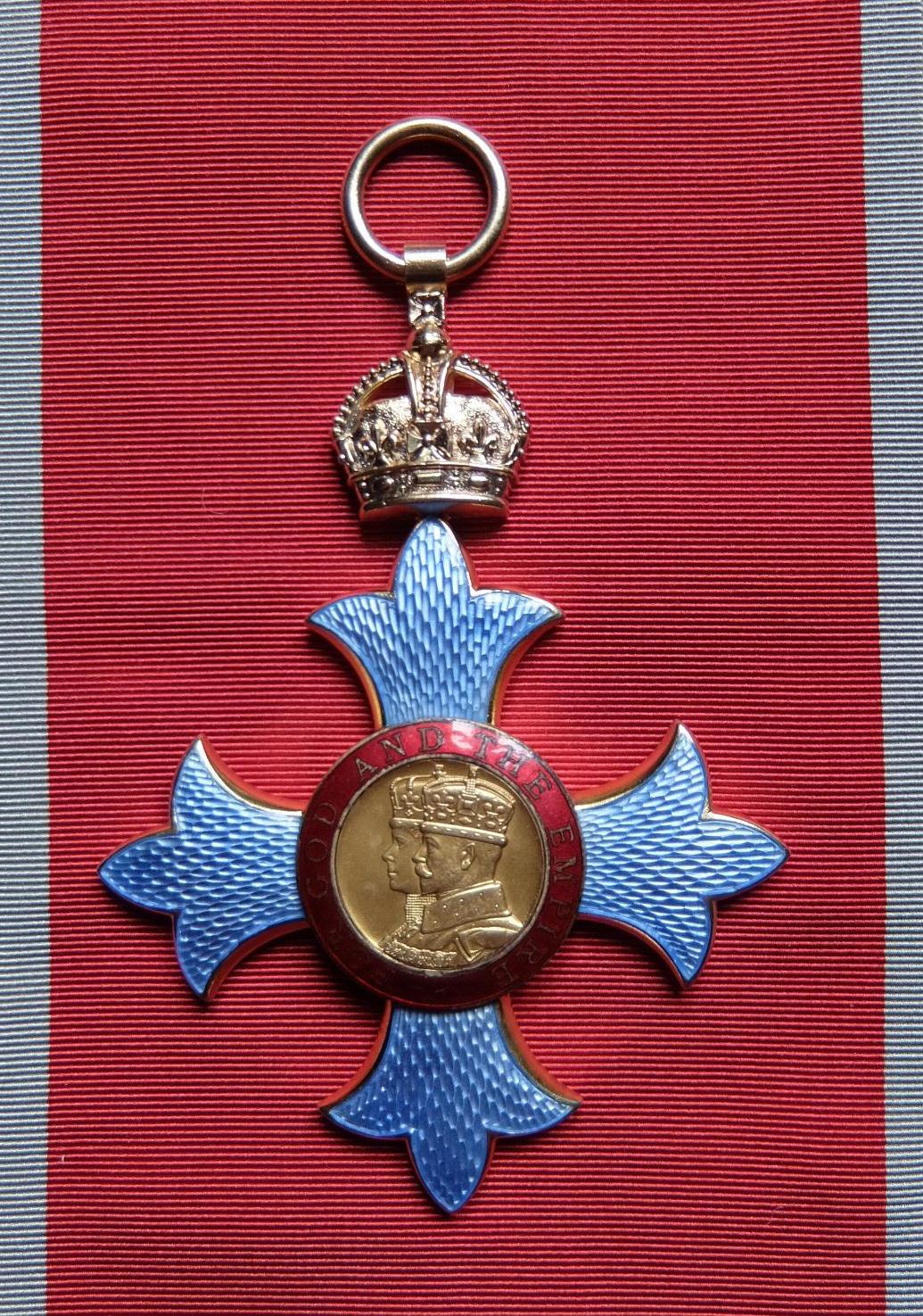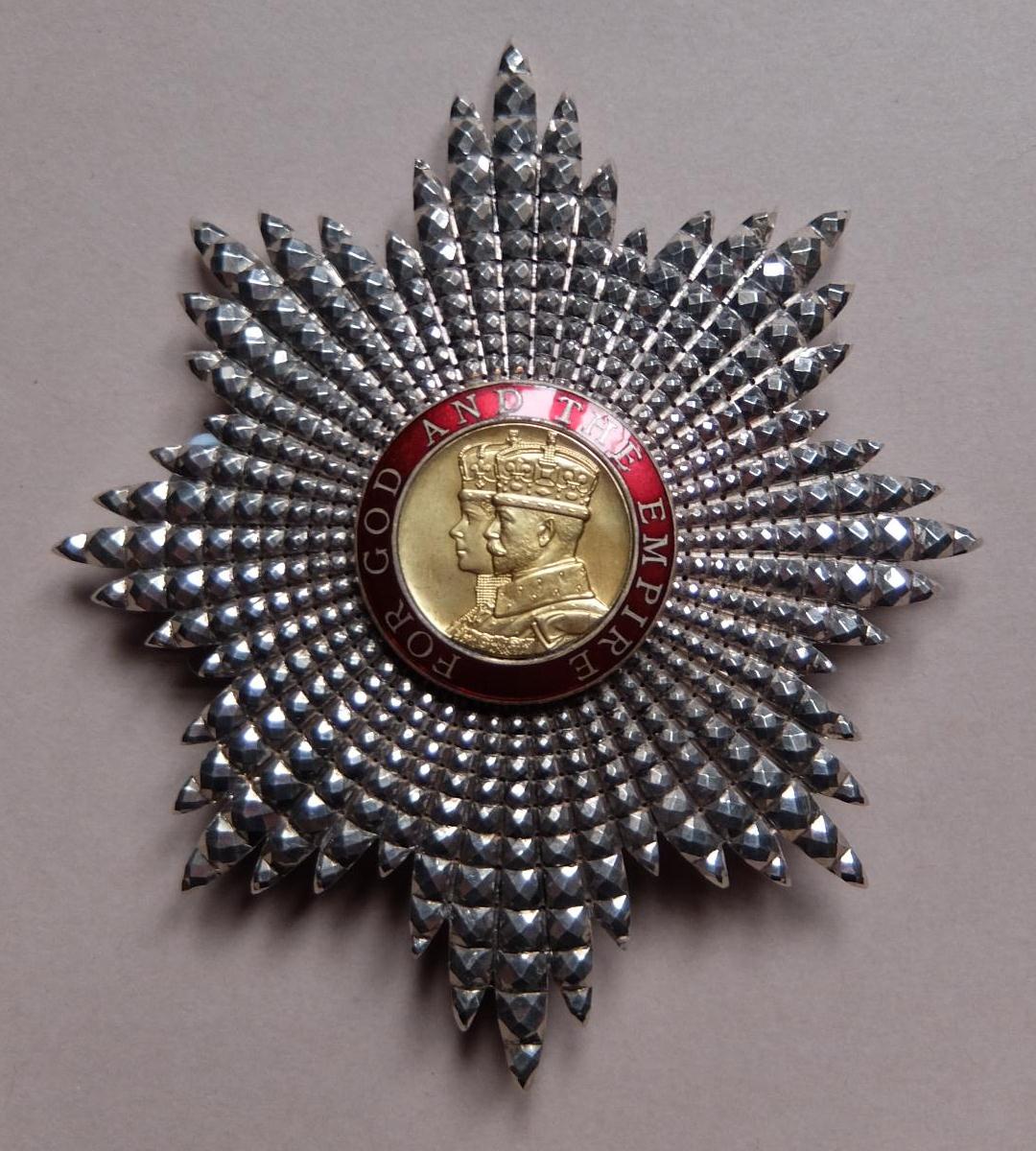This article describes developments in the Order from the end of 1922, through to the major change to the members’ insignia in 1937.
The 1922 constitution
New statutes that were issued in December 1922 restricted the membership of the Order for the first time, limiting the first (GBE), second (KBE/DBE) and third (CBE) classes to 70, 210 and 860 respectively (Gazette issue 32781). No overall maxima were placed on the fourth and fifth classes, but annual limits were set at around 200 OBEs and 300 MBEs.
The important features of the 1922 constitution include the dominance of civil awards, accounting for more than 80 per cent of the total, and the allocation of half of the civil places to recipients from outside the UK.
The insignia was unaltered, but the role and pattern of the medal were amended, allowing it to be awarded to those who performed acts of gallantry or rendered meritorious service. The gallantry award came to be known as the Empire Gallantry Medal, while the meritorious service version was renamed the British Empire Medal in 1941.
No section of the Order was dedicated to rewarding acts of gallantry, although a few appointments were made for that reason, including awards to merchant marine officers for an action in recovering their vessel which had been captured by pirates off the coast of China (Gazette issue 33280), and an MBE for Mary Robertson, a nurse at an asylum in Peru who was rewarded ‘for bravery in disarming a criminal lunatic’ (Gazette issue 33946).
The 1923 New Year Honours list (Gazette issue 32782) reported the first appointments under the recent statute, and set the pattern for the future, with military division recommendations coming from the first lord of the Admiralty and the secretaries of state for war and air, and with four civil sections, where the main UK nominations were joined by lists from the secretaries of state for foreign affairs, India and the colonies. The only major change to this approach during the remainder of King George V’s reign was the introduction of a dominions list, after the formation of that department in 1925.
Most British Empire appointments appeared in the Birthday honours list until 1929, and since then, two lists have been gazetted each year. While it is difficult to determine exact numbers and classifications (for a variety of reasons), the following table provides a broad indication of the appointments and promotions announced in the New Year and Birthday lists published between January 1923 (Gazette 32782) and February 1937 (Gazette 34365) (inclusive):
|
Division |
Type/class |
GBE |
K/DBE |
CBE |
OBE |
MBE |
Total |
|
Civil |
United Kingdom |
32 |
122 |
475 |
946 |
1,341 |
2,916 |
|
Colonial Office |
3 |
44 |
182 |
457 |
434 |
1,120 | |
|
Dominions Office |
4 |
32 |
132 |
180 |
212 |
560 | |
|
Foreign Office |
6 |
28 |
90 |
183 |
218 |
525 | |
|
India Office |
4 |
21 |
77 |
262 |
379 |
743 | |
|
Military |
Admiralty |
5 |
17 |
52 |
115 |
102 |
291 |
|
Air Ministry |
1 |
5 |
20 |
56 |
75 |
157 | |
|
War Office |
2 |
28 |
136 |
532 |
745 |
1,443 | |
|
Total |
57 |
297 |
1,164 |
2,731 |
3,506 |
7,755 |
Inter-war nominations were approved at an average rate of fewer than 600 a year, covering the UK and its extensive empire, which contrasts with a figure of around 2,100 awards in 2016 for little more than the UK itself, showing how far the scope of the Order has been extended during the present reign.
Notable events
A few special lists dealt with the response to natural disasters and other matters. The first such list was gazetted in 1923 and followed an earthquake in Japan (Gazette issue 32892), with later examples including honours for combating fires on St Lucia, floods in Lancashire and hurricanes in Mauritius, while one of the largest distributions followed an earthquake in Baluchistan (Gazette issue 34221).
The membership limits were revised periodically, starting in 1924, when a statute allowed for additional appointments for military operations in Waziristan. Between then and the changes to the insignia in 1937, a variety of other actions were recognised, mainly relating to campaigns in India, but also in Iraq, Kurdistan and Sudan, while some nominations rewarded work done during the civil unrest in Cyprus and Palestine.
A number of events were noticed by the British Empire. Examples from 1924 involved:
- The termination of the British South Africa Company’s administrative role in what is now Zimbabwe.
- The centenary of the Royal National Lifeboat Institution (RNLI).
- The completion of the salvage of 40 tons of gold from the liner Laurentic, which sank off the north Irish coast in 1917 after striking an enemy mine (Gazette issue 33000).
The RNLI awards were unusual, in that the Order’s medal was given to surviving holders of the Lifeboat Institution’s gold medal, including Herbert Burton, who was honoured for rescuing a hospital steamer off Whitby in 1914 and had also gained an OBE for his war service as a major in the Royal Engineers. Another gold medallist was Henry Blogg, who received the Empire Gallantry Medal in 1924 and a civil British Empire Medal 17 years later, for rescuing the crew of ships stranded on the sands off Cromer (Gazette issue 32953 and Gazette issue 35347).
The special lists continued during the 1920s, with honours to mark the centenaries of the railway industry and the Metropolitan Police; the Prince of Wales’s visit to Africa and South America; Stanley Baldwin’s resignation as prime minister; and the closing of the British Empire Exhibition.
The Order did not operate uniformly throughout the British Empire, but instead reflected local preferences. The Canadian and South African legislatures took steps to limit the use of imperial honours, although both countries returned to the Order in later years, mainly in response to World War 2. A notable OBE from this period was Lester Pearson, the future prime minister of Canada, who played an important role in creating the Order of Canada in 1967.
New insignia
The British Empire’s insignia was revised in 1929 to align it with many other Orders, by allowing the grand crosses to wear a mantle of purple satin and a gold collar with links decorated with sea lions and royal symbols. Two holders of this elaborate insignia were Lady Baden-Powell of the Girl Guide movement, and Sir John Reith, who helped to establish the British Broadcasting Corporation.
The membership limits increased again in 1933, when holders of the gallantry medal were authorised to add a branch of laurel to their riband and to place letters (EGM) after their name (a privilege not given to holders of the BEM until 1942).
King Edward VIII’s short reign in 1936 had a limited impact on the Order, with fewer than 400 awards being made. The only significant developments were the nomination of his mother, Queen Mary, to succeed him as grand master and so take responsibility for countersigning the warrants of appointment, and a review of the insignia, which would lead to reforms that were implemented after his abdication.
Queen Mary served as grand master until her death in 1953, and is remembered today in the Order’s insignia, which was changed by statute of 9 March 1937, when Britannia was replaced on the badges, stars and mantles by the crowned effigies of King George V and Queen Mary by the artist Percy Metcalfe; the colour of the riband changed from purple to what was described as ‘rose pink edged with pearl grey’ (with a vertical pearl grey stripe in the centre for most military division awards); the wording ‘Instituted by King George V’ was added to the reverse of the medal; and a new seal was provided, replacing the original Britannia pattern with a design which paired the new badge with the royal arms.
News about the insignia was announced shortly before the coronation of King George VI in May 1937, when a statement explained that: the colours for the Order – rose pink and pearl grey – had been altered ‘in commemoration of the reign of King George V and Queen Mary, during which the Order was founded’, and existing ribands would not have to be changed, but holders would be ‘permitted to make the alteration if they so wish, at their own expense’ and were able to apply to the Central Chancery of the Orders of Knighthood at St James’s Palace to purchase insignia of the new pattern, provided that the old insignia was surrendered.
Distribution
The last New Year honours list to appear before the introduction of the new insignia was gazetted on 1 February 1937 (Gazette 34365), and demonstrated the way in which the Order had developed during its first 20 years, with separate military division nominations from the Admiralty, War Office and Air Ministry lists. The recipients included Major General John Kennedy, the colonel of The Buffs who received a military KBE and was one of several officers who later transferred division, being promoted to civil GBE in 1946, following service as vice chairman of the joint war organisation of the Red Cross and Order of St John.
The civil awards reflected work throughout the UK departments of state, schools, police forces, hospitals and other public organisations, as well as activities described as ‘political and public service’. The Foreign Office recognised contributions by officials in embassies and legations; services rendered by British residents in countries such as Greece and Japan, including an OBE for the professor of English at Coimbra University in Portugal and an MBE for one of the King’s messengers.
The Dominions list presented awards for work in countries such as Basutoland, New Guinea, New Zealand, Newfoundland, Southern Rhodesia and Swaziland, and included a CBE for Donald Mackay for scientific exploration in the interior of Australia, and honours to mark the centenary of the state of South Australia.
The India Office nominations covered activities ranging from forests and horticulture to excise and engineering, as well as business and transport operations and police and prison services. The colonial list rewarded work in Gibraltar and Hong Kong and in several of the African, Pacific and West Indian colonies. Honours were also granted in connection with the civil disturbances in Palestine, including the award of several medals, which had effectively – though not formally – begun to function as a sixth class of the Order.
Several recipients of these honours were received by the King at Buckingham Palace on 25 February 1937, in what was the last major investiture to be held before the insignia changed. The final name in the Court Circular list was that of Thomas Wilson, who earned his MBE with the Board of Customs and Excise, and the King also presented an Empire Gallantry Medal to Charles Duffin, for bravery in rescuing a diver at Portsmouth Dockyard (Gazette issue 34365).
Two years after King George and Queen Mary first appeared on the British Empire’s insignia, the Order found itself being called on – once again – to provide the means of honouring the men and women who sustained a war effort, this time against the Axis powers.
About the author
Russell Malloch is a member of the Orders and Medals Research Society and an authority on British honours.
Pictured: 1937 pattern badge and star of a knight grand cross (GBE)